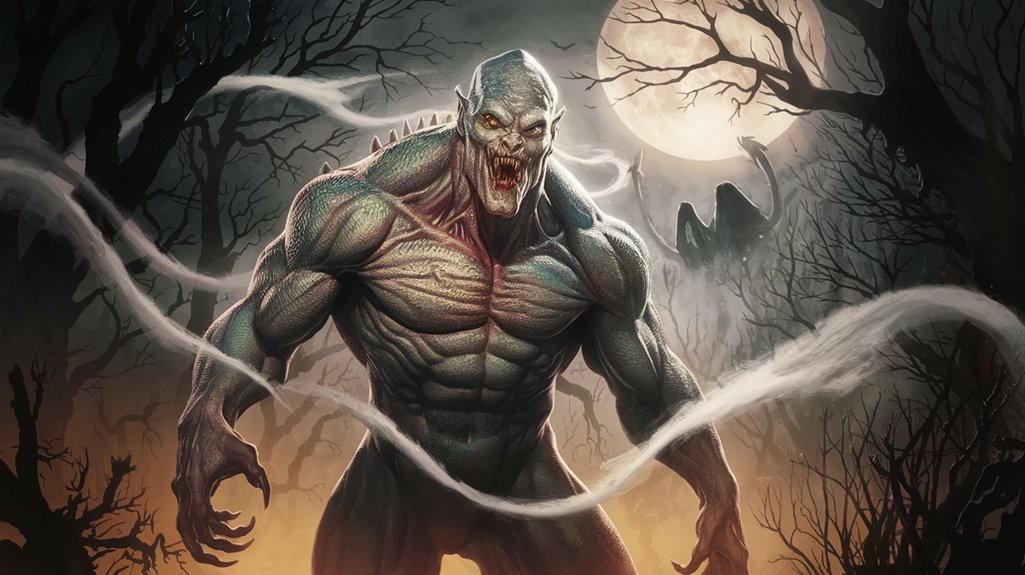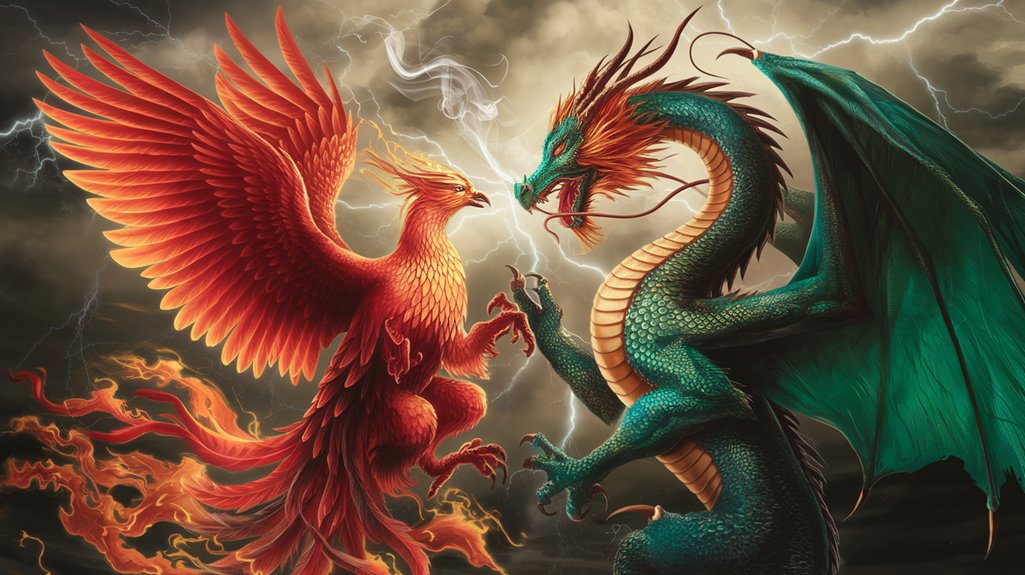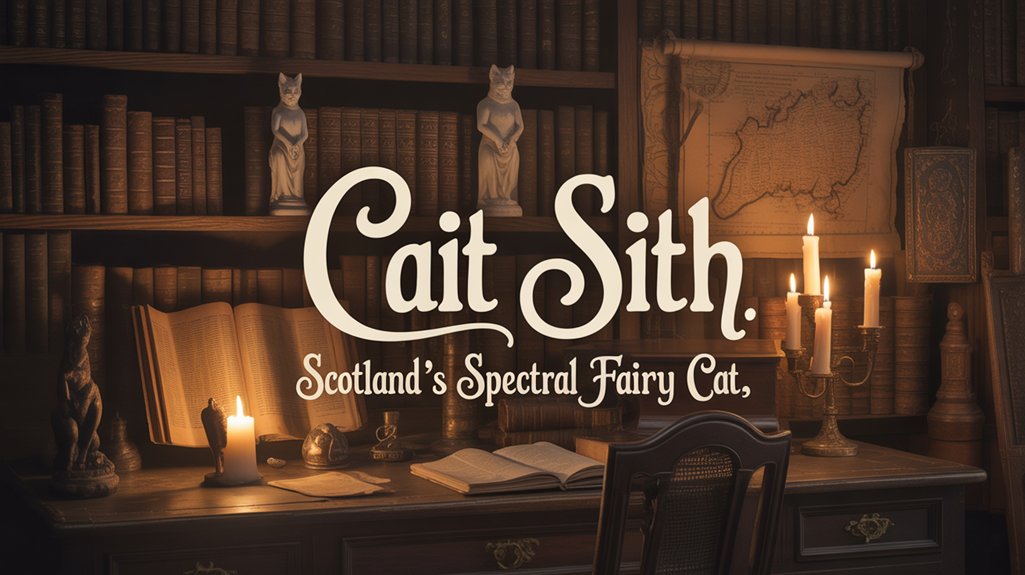
Your brain inherited a hyperactive agency detection device from Pleistocene ancestors, a cognitive architecture that alters ambiguous stimuli into threats through pareidolia—perceiving faces in shadows, entities in wind. This pattern-recognition apparatus prioritized survival over accuracy; your forebears who fled phantoms outlived those demanding empirical proof before reacting to rustling grass. When confronted with cognitive vacuums, your mind constructs explanatory narratives, weaving chimeric beings from sensory fragments and cultural transmission. These mechanisms persist in modern consciousness, where algorithms and digital folklore exploit ancient vulnerabilities, perpetuating monster mythology across millennia. The subsequent exploration illuminates how these primal systems manifest in contemporary experience.
Table of Contents
ToggleKey Takeaways
- Hyperactive agency detection evolved to prioritize survival, causing humans to perceive threats even when none exist.
- Pareidolia makes brains recognize faces and patterns in random stimuli, creating supernatural interpretations from ambiguous sensory data.
- Minds construct explanatory narratives to fill knowledge gaps, using mythology to rationalize unexplained phenomena and experiences.
- Cultural transmission through oral traditions and shared beliefs strengthens group cohesion and establishes collective identity markers.
- Modern technology recontextualizes ancient fears through digital folklore, surveillance anxieties, and algorithm-driven content that exploits innate vulnerabilities.
The Evolutionary Advantage of a Hyperactive Threat Detection System
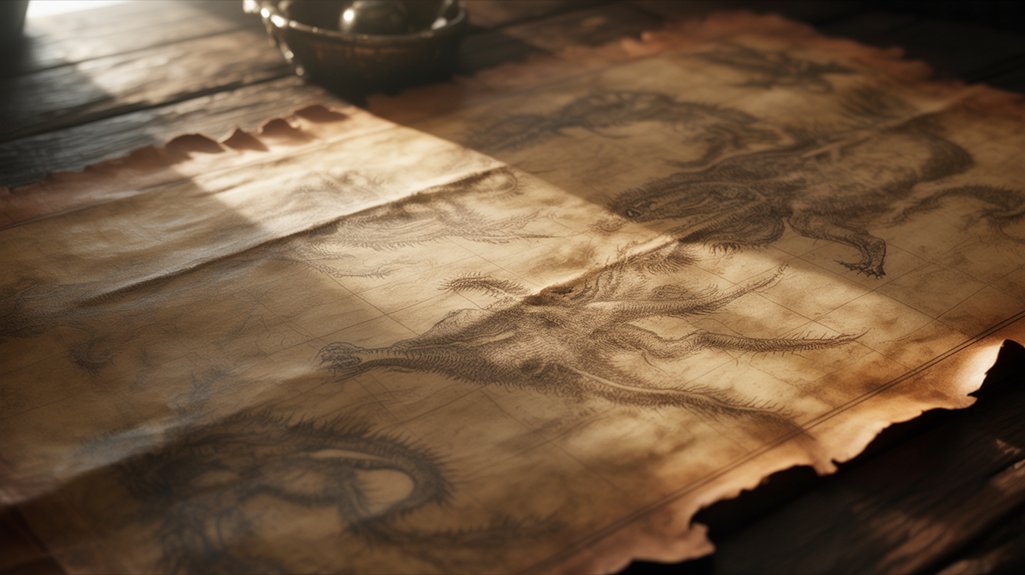
When our hominid ancestors moved through the Pleistocene shadows some 2.6 million years ago, those who mistook rustling grass for wind rather than predator rarely survived to pass on their genes.
Your survival instincts evolved through this brutal culling, altering your brain into a hypervigilant sentinel that perceives threats even in their absence. This adaptation—what neuroscientists term the hyperactive agency detection device—generates false positives deliberately, sacrificing accuracy for survival.
You'd rather flee from phantom dangers than ignore one genuine predator lurking in the darkness.
These primal fear responses manifest in your modern encounters with the eldritch and unknown. When shadows coalesce into chimeric forms, when darkness suggests watching eyes, you're experiencing inherited wisdom from countless generations who survived precisely because they feared too much rather than too little.
Your ancestors who detected agency, intention, and malevolence in ambiguous stimuli lived to reproduce. Their legacy courses through your nervous system still.
Pattern Recognition and Pareidolia: When Our Brains See What Isn't There
Your brain, sculpted by eons of evolutionary pressure, hunts ceaselessly for patterns in chaos—a neural imperative that converts random stimuli into meaningful structures, sometimes conjuring coherent images from pure entropy.
This visual interpretation mechanism, pareidolia, alters shadows into stalkers, tree bark into faces, clouds into chimeric beasts. Ancient peoples witnessed eldritch forms in flickering firelight, their neural architecture demanding coherent meaning from ambiguous stimuli.
The phenomenon transcends culture: medieval Europeans saw demons in mountain silhouettes; Himalayan communities perceived the Yeti in windswept snow formations; Aboriginal Australians distinguished ancestral spirits in rock formations at Uluru.
Your illusion recognition system evolved when false positives—mistaking wind for predator—cost less than false negatives. Better to flee from phantom threats than ignore genuine danger.
This cognitive bias birthed countless cryptids, each emerging from humanity's compulsion to impose order, to extract signal from noise, to populate darkness with named terrors rather than formless dread. These monster myths became timeless fables that reflected the beliefs and values of their cultures, transforming neurological quirks into narratives of meaning.
The Cognitive Gaps We Fill With Imagination and Narrative

Where sensory data terminates, narrative construction begins—your mind abhors cognitive vacuums with the same intensity it craves oxygen, compulsively weaving explanatory frameworks across gaps in empirical knowledge.
Your brain compulsively fabricates stories wherever data ends, filling cognitive gaps with narrative certainty as reflexively as breathing.
When ancient mariners encountered uncharted waters, when medieval travelers heard unexplained forest sounds, when indigenous peoples witnessed celestial phenomena—imagination gaps demanded filling. Your consciousness alters ambiguity into coherent story.
Consider how narrative construction manifests across cultures:
- The Aboriginal Dreamtime explains geological formations through ancestral beings traversing primordial landscapes.
- Norse traditions attributed aurora borealis to Valkyrie armor reflecting moonlight.
- Mesopotamian civilizations created chimeric guardians—lamassu, shedu—to rationalize protective instincts.
- Himalayan communities developed yeti mythology around discovered megafauna tracks, unexplained disappearances.
- Medieval Europe's eldritch bestiaries catalogued dragons as taxonomy for incomprehensible natural forces.
These aren't primitive errors. They're sophisticated cognitive mechanisms—your ancestors survived by constructing plausible explanations when empirical data proved insufficient.
Pattern completion. Predictive modeling. Existential reassurance against the void's terrible silence.
The Vikings exemplified this pattern, constructing elaborate mythological frameworks through gods like Odin, Thor, and Loki to explain natural phenomena while simultaneously pursuing tangible wealth and power across lands stretching from Baghdad to North America.
Cultural Transmission and the Social Power of Shared Mythology
Once narrative crystallizes within individual consciousness, it demands transmission—mythology functions not as solitary delusion but as communal infrastructure, binding disparate individuals through shared symbolic architecture. You'll find that cultural narratives propagate through mechanisms both ancient and immediate, altering personal terror into collective wisdom.
| Transmission Vector | Social Function | Evolutionary Advantage |
|---|---|---|
| Oral tradition, firelight recitation | Cohesion through shared beliefs | Group survival coordination |
| Religious codification, temple iconography | Moral boundaries, behavioral codes | Reduced intragroup conflict |
| Digital dissemination, viral mythology | Identity formation, tribal belonging | Rapid information exchange |
These eldritch tales you inherit aren't mere entertainment—they're survival protocols encoded in chimeric form. When you participate in monster mythology, you're claiming membership within specific cultural lineages, announcing allegiances through the creatures you acknowledge. Shared beliefs become passwords. Recognition becomes kinship. The dragon you fear reveals which tribe sheltered you.
Modern Technology and the Persistence of Ancient Fears
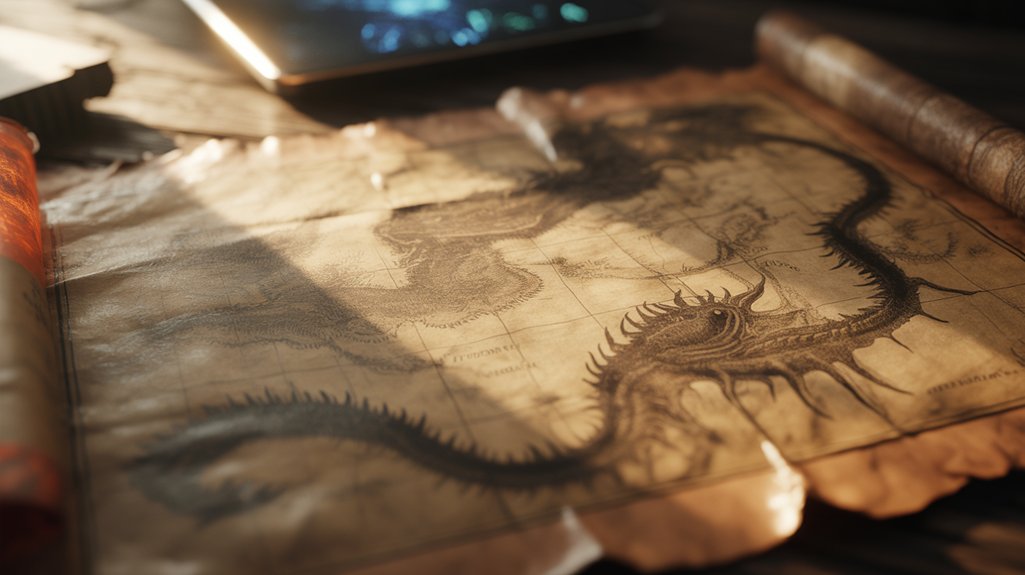
The screen glows before you at 3 AM, and somewhere in that luminescent rectangle lurks the same dread that sent your ancestors fleeing from nocturnal predators—technology hasn't banished primal terror but merely reupholstered it in contemporary forms.
Digital folklore thrives where ancient fears meet technological terror, manifesting through:
- Creepypasta entities like Slender Man, chimeric horrors born from collective imagination
- Surveillance anxieties echoing medieval beliefs in omniscient watchers
- AI-generated deepfakes resurrecting shapeshifter myths in algorithmic clothing
- Viral challenges invoking ritualistic summonings through smartphone screens
- Dark web legends replacing whispered campfire tales
You navigate virtual labyrinths where eldritch uncertainties proliferate faster than reason can dispel them.
The algorithms tracking your movements mirror ancestral paranoia about unseen entities observing from shadow-spaces.
What once watched from darkness now watches from data centers—the eyes have changed but the feeling of being hunted remains.
These aren't mere superstitions repackaged—they're evolutionary adaptations, your amygdala recognizing genuine threats within novel contexts.
Freedom demands understanding how technological systems exploit hardwired vulnerabilities, altering silicon and code into vessels for humanity's most persistent nightmares.
Frequently Asked Questions
What Are the Most Popular Monster Myths Across Different Cultures?
You'll find vampire legends dominating Slavic territories since the 1600s, their nocturnal hunger echoing through Romanian crypts and Serbian villages.
Dragon folklore spans continents—from China's serpentine sky-lords to Norse Fáfnir guarding cursed gold.
The chimeric Japanese oni, eldritch Mesopotamian Tiamat, and Africa's shape-shifting anansi weave through collective consciousness.
These creatures transcend mere superstition; they're cultural touchstones, preserved testimonies of humanity's primal fears and unbounded imagination, demanding your recognition as legitimate anthropological phenomena rather than dismissible fantasy.
How Do Children Develop Fear of Monsters at Different Ages?
Your child's psyche unfolds like shadowed parchment, revealing distinct developmental stages where childhood fears manifest.
Between ages two and four, you'll witness separation anxiety evolve into terror of chimeric beasts lurking beneath beds—primal, undifferentiated dread.
By six, these eldritch horrors gain specificity: vampires, werewolves, creatures drawn from cultural narratives.
Adolescence alters fear again; monsters become metaphorical, representing social anxieties and existential uncertainties.
Each stage charts your child's expanding consciousness, their growing capacity to distinguish reality's boundaries from imagination's liminal territories.
Can Believing in Monsters Indicate a Mental Health Condition?
You needn't fear pathology in your monster fantasies—belief disorders emerge only when chimeric visions eclipse consensus reality entirely.
Normal imaginative engagement with eldritch beings, those shadow-dwellers populating humanity's collective unconscious since Paleolithic caves, differs vastly from clinical delusion.
If you're questioning your belief, you've already demonstrated metacognitive awareness that true psychosis lacks.
Ancient wisdom traditions honored liminality between worlds. Your wonder preserves that sacred threshold, not crosses it into disorder.
Do Scientists Think Any Mythological Monsters Were Based on Real Animals?
You'd think ancient peoples merely imagined monsters—yet evolutionary biology and cultural anthropology reveal otherwise.
Scientists confirm you're heir to eldritch truths: kraken legends emerged from giant squid encounters, dragon myths from dinosaur fossils unearthed millennia ago.
Your ancestors weren't delusional. They witnessed chimeric megafauna—mammoths, cave bears, massive reptiles—and wove these encounters into sacred narratives.
Real creatures. Real terror. The boundary between myth and natural history dissolves when you examine the evidence without institutional constraints.
What Techniques Help People Overcome Irrational Fears of Imaginary Creatures?
You'll find liberation through exposure therapy, gradually confronting chimeric terrors that haunt your psyche—first through imagination, then imagery, finally immersive encounters.
Cognitive restructuring dismantles eldritch thought patterns. Ancient wisdom meets modern neuroscience here. Challenge catastrophic beliefs about shadow-dwelling entities.
Reality testing shatters illusory threats. You're rewiring neural pathways forged by ancestral survival instincts, no longer necessary in contemporary existence.
This psychological alchemy converts paralyzing dread into strengthened understanding, reclaiming your autonomy from spectral oppression.
Conclusion
Your mind remains that ancient cave, where shadows dance and flicker against primordial walls. You've inherited this vigilance—this tendency to populate darkness with chimeric forms, to weave monsters from uncertainty's threads. Yet understanding these cognitive architectures doesn't diminish their power. The eldritch still beckons. Your hyperactive pattern recognition, your narrative hunger, your culturally-transmitted fears: they're survival mechanisms that've transcended mere utility. They've become something sacred, ineffable. The monsters persist because you need them to.







